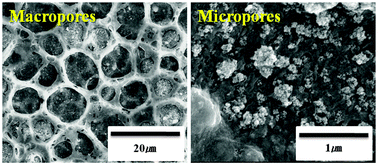Ceramic composite separators coated with moisturized ZrO2 nanoparticles for improving the electrochemical performance and thermal stability of lithium ion batteries
Abstract
We introduce a ceramic composite separator prepared by coating moisturized ZrO2 nanoparticles with a poly(vinylidene fluoride-co-hexafluoropropylene) (PVdF-12wt%HFP) copolymer on a polyethylene separator. The effect of moisturized ZrO2 nanoparticles on the morphology and the microstructure of the polymeric coating layer is investigated. A large number of micropores formed around the embedded ZrO2 nanoparticles in the coating layer as a result of the phase inversion caused by the adsorbed moisture. The formation of micropores highly affects the ionic conductivity and electrolyte uptake of the ceramic composite separator and, by extension, the rate discharge properties of lithium ion batteries. In particular, thermal stability of the ceramic composite separators coated with the highly moisturized ZrO2 nanoparticles (a moisture content of 16 000 ppm) is dramatically improved without any degradation in electrochemical performance compared to the performance of pristine polyethylene separators.


 Please wait while we load your content...
Please wait while we load your content...